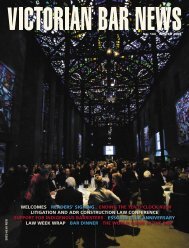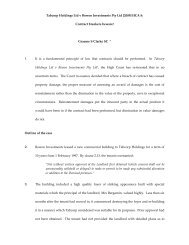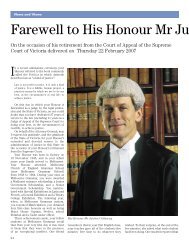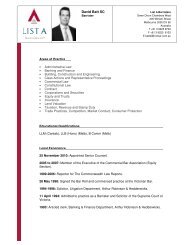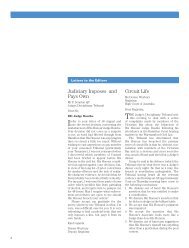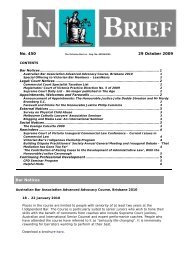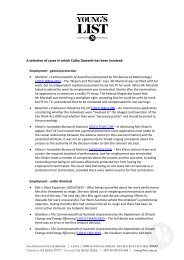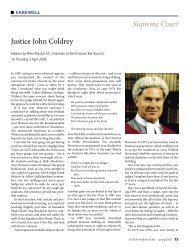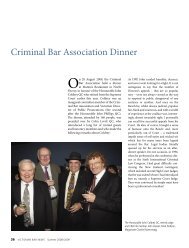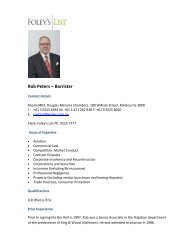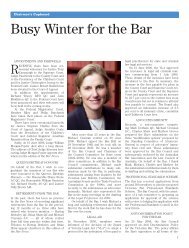Justice William Charles Crockett AO - Victorian Bar
Justice William Charles Crockett AO - Victorian Bar
Justice William Charles Crockett AO - Victorian Bar
- No tags were found...
Create successful ePaper yourself
Turn your PDF publications into a flip-book with our unique Google optimized e-Paper software.
Lawyer’s BookshelfContract Law inAustralia (5th Edn,2006)By Carter, Peden and TolhurstIT is always a pleasure to see a new editionof a significant and well regardedlegal text come onto the market. The fifthedition of Contract Law in Australia isno exception.This latest edition continues the style,content and format of previous editions,although it is noted that some chaptershave been shortened for the ease of useof law teachers and reference by practitioners.Two new chapters appear in thetext, namely “Good Faith” (chapter 2)and “Assignment of Contractual Rights”(chapter 17).The text, at 991 pages including theindex, is as comprehensive as its predecessors.The inclusion by the publishers(whether intentionally or otherwise) of 10utterly blank pages after the index is presumablyto facilitate the creation and useof crib notes by students. This innovationis to be commended and encouraged in allfuture publications from Butterworths.The fact that the text itself is wellover 950 pages in length does make thisreviewer wonder how on earth a text ofsuch breadth and depth can be a usefultool for students in the modern law schoolcurricula where Contract Law (ContractLite?) is taught in a one-semester tsunamiof cases, principles and so-called Socraticdialogue.Whilst the modern trend to shortercourses on such foundation subjects is tobe rightly deplored, this is not the fault ofthe authors or the publisher but it doeslead one to ask about the identity of theaudience the book is intended to reach.In this reviewer’s not so humble opinion,the book is now of such a respectablevintage (it’s been around for over 21years) the authors can rightly claim it asprimarily a practitioner text and should,after the style of Chitty, produce onlyclothbound versions. The reviewer’s copy(although freely acquired and gratefullyaccepted) is softcover, which somehowjust doesn’t have the gravitas that thebook would otherwise convey as a hardbackversion strategically laid on the <strong>Bar</strong>table in front of an appellate bench.This reviewer would like to see anextension to the introductory chapterwhere it addresses the jurisprudentialunderpinnings of the law of contract (contractualpromises are, after all, the only78way in which we are able to predict thefuture) and a discussion of the good faithprinciples from an historical perspective(would the great common lawyers of thepast such as Lords Blackburn and Jesselhave countenanced the brutal Hobbesianapproach towards an overarching doctrineof good faith adopted by the <strong>Victorian</strong>Court of Appeal in Esso AustraliaResources Pty Ltd v Southern PacificPetroleum NL & Ors [2005]VSCA 228.The additional chapter on assignmentof contractual rights should be compulsoryre-reading for all practitioners under75 years of age. This reviewer is drivento constant distraction by the number ofcontracts that come across his desk withclauses that recite the ability of the nonregalparties to assign contractual rightsand liabilities.The reviewer was disappointed to seethat there is no reference to the statutoryregime that controls and qualifies domesticconstruction contracts in Victoria, butthen again you can’t cover everything ina volume of general principles. Perhapsthere is a market for a second volumedealing with specific contracts, again ala Chitty.All in all this is a splendid volume andwell worth its place in chambers or withineasy reach of the busy solicitor’s desk.The Law of InsiderTrading in AustraliaNeil McPheeBy Gregory Lyon andJean J du PlessisThe Federation Press, 2005Pp. v–204, Bibliography 205–212,Index 213–218THE Law of Insider Trading inAustralia is principally an analysisof the legislative provisions in theCorporations Act 2001 (Cth) which prohibitinsider trading.The authors deal first with the complexcharacter and operation of the prohibition,including an examination of key elementssuch as who is an “insider”, what is“inside information” and when is information“generally available”. The range ofdefences and exceptions to the prohibitionis then examined, noting that nonehas been judicially tested. The authorsthen consider the criminal penalties andcivil remedies for proven breaches of theinsider trading provisions, with particularfocus on the relatively recent availabilityof civil penalties. The final chapter dealswith the difficulties of enforcement andthe inter-relationship between insidertrading and continuous disclosure.The text includes a very useful appendixof Australian civil and criminal insidertrading cases to which can now be addedthe decision of the NSW Court of CriminalAppeal in Hannes v DPP delivered on 24November 2006 (2006) NSWCCA 373.The appendix highlights the relatively fewprosecutions and civil proceedings thathave been instituted in this area.The exposition is detailed and systematicand brings together key conceptsessential to an understanding of this areaof the law. It also addresses the fundamentalquestions of whether Australia’s insidertrading laws are necessary, desirable andeffective.The authors display an authoritativecommand of their subject. This comprehensivework will be an essentialreference point for those prosecuting ordefending insider trading cases and thosewith an academic interest in the area.P.W. Almond QCMagna Carta LectureTHE Society was represented at the2006 Magna Carta Lecture, hostedjointly by the British High Commissionand the Honourable J.J. Spigelman, AC,Chief <strong>Justice</strong> of NSW, at the Banco Court,Sydney, on 13 September. The lecture wasdelivered by Lord Falconer of Thoroton,the Lord Chancellor, on the topic: TheRole of Judges in a Modern Democracy.This annual series of lectures was inauguratedin 2002 by the British Governmentand forms part of a program of significantsupport it gave to celebrations markingthe Centenary of Federation in 2001.This also included a generous donationto an Australia–Britain Society projectthat culminated in the commissioningthat year of a monument to Magna Cartaset in a parkland site to the west of OldParliament House in Canberra and nowdesignated “Magna Carta Place”.In some preliminary remarks beforedelivering the lecture, Lord Falconercommented that he was the first LordChancellor in 1,100 years to visit Australiawhile England held the Ashes.Copies can be made available electronicallyon request to the Executive Officeron e-mail mblongstaff@ozemail.com.au.



